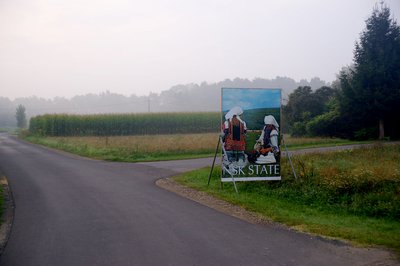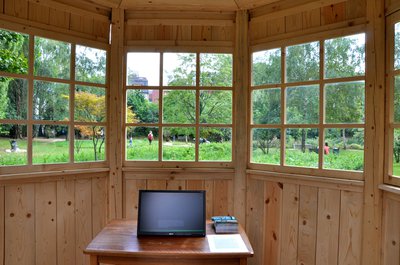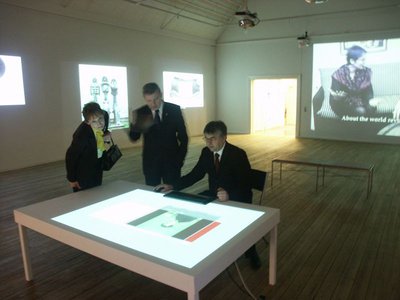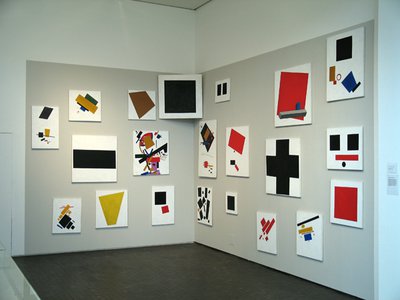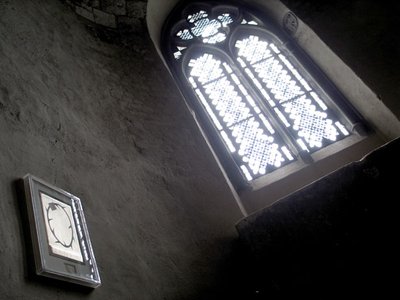Review of the exhibition "IRWIN-RETROPRINCIP 1983-2003" at Kunstlerhaus Bethanien in Berlin by Hanno Reichel
From 26.09.2003 to 26.10.2003, Berlin's "Kunstlerhaus Bethanien" paid tribute to 20 years of IRWIN with the retrospective exhibition "IRWIN-RETROPRINCIP 1983-2003".
Prologue
The main idea of the exhibition's curator Inke Arns was to present selected pieces from all of IRWINs working periods embedded into a concept of interpreting and explaining the political and artistic background of the group during these two decades in European history. This was to be achieved by the means of certain specific works brought back again into their original context and by the same time linking them to the totality of IRWIN's development in time. In this sense, the exhibition -which was after IRWIN's presentation in Kunsthalle Dusseldorf in 1989 their first large solo exhibition in Germany- wanted to move beyond the spheres of a usual gallery-like presentation of artwork, and be some kind of "IRWIN-Navigator".
The exhibition took place in Studio 1 and 2 of "Kunstlerhaus Bethanien" which is located in the alternative/artist quarter of Berlin-Kreuzberg right in the center of Germany's capitol between former East and West and thus the most perfect location for an IRWIN-retrospective in Germany that can be thought about. As even the global art of NSK would always be subject to interference with its geopolitical surroundings (mind the IRWIN-ideas of movement, spheres and vehicles of art) where would it be better hosted than right in the center of what is ought to be the Nouva Europa that NSK emerged from? Various kinds of cross-roads between the old and new East and West. Ljubljana, Sarajevo, Berlin, you name it.
In spatial -and in some way by the same time contextual- terms, the exhibition was divided into three main sections:
The groundfloor of Studio 1 hosted in its wings the oldest works with parts of the "Rdeci Revirji"- and "Slovenske Athene"-series and in its center larger and newer installations from the "Transnacionala-" and "ICONS-"-projects as well as an installation called The Interior of the Planit", consisting essentially of a model of the virtual "NSK-State-in Time".
High above the groundfloor, the gallery hosted -besides some other pieces- works from the series "Transcentrala: New York, Moskau, Ljubljana 1992-1997", "Was ist Kunst Deutschland" and the "State-in-Time"-related project "NSK Garda".
Studio 2 mainly contributed to the above-mentioned idea of approaching an overall-interpretation of IRWIN and their past works: This was done with the installations "Retroprincip", "Retroavantgarda" and "East Art Map", a selection of IRWIN-related books and finally a documentary video-program.
Thus, in the spirit of the aim of curator Inke Arns, with this review I want to try to not only give a documentation of what could be seen, but adapt the already existing different general interpretations of IRWIN's artist principles to specific works to point out possible versions of interpretation of these works from todays view.
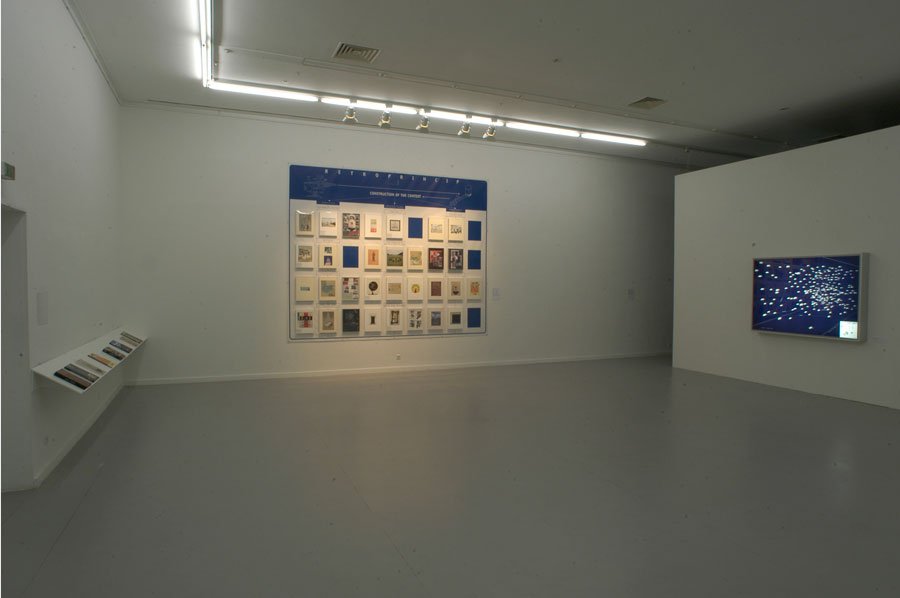
 IRWIN: RETROPRINCIP 1983-2003, Kunstlerhaus Bethanien, Berlin, 2003
IRWIN: RETROPRINCIP 1983-2003, Kunstlerhaus Bethanien, Berlin, 2003
Back to the future: "Rdeci Revirji" and "Slovenske Athene"
This part of the oldest exhibited works featured first of all two works of the "Rdeci Revirji"-series from 1985 with its blood-soaked adaptions of former traditional coalminer's art showing industrial locations in the Trbovlje-area. Interesting to mention that the former originals of these works copied, used and recontextualized by IRWIN were created by Slovene artist Janez Knez, father of LAIBACH-/NSK-cofounder Dejan Knez. The basic principle of these works already gives an idea of IRWINs early principle of radical decontextualisation and adaptation of existing works to lead them over to another appearance and thus changing their former meaning and message to something totally different. In these specific images, IRWIN enlarged the original motives, soaked them with blood and framed them in front of a background made of coal. Thus, the originals that must have had -besides any revolutionary/socialist background- some air of "romantic" proletarian imagery, were brought into the rough context of grim reality: In this sense, the enlargement of the motives might represent the development to faster and faster growing industrial enterprises with growing need for human and technical resources and by that more and more dehumanising the process of labour and production. This process of dehumanisation is then further symbolized to the extreme by connecting it to the pieces of coal as signs of dirty and heavy work and the blood as an almost religious symbol for human suffering caused by these circumstances. In this sense, IRWIN transformed the originals –that must in their basic version have been subjects to possible ideological corruption- into superior art-documents of an eternal and incorruptable reality.
The two exhibited monumental works of originally five pieces of the "Slovenske Athene"-series date back to a 1987-project of IRWIN, encouraging different Slovenian artists to create imagery of the Sower as a traditional Slovenian national symbol in front of backgrounds representing the five main Slovenian landscapes. In the final result, IRWIN did not only demythologise this national symbol by its monotone repetition (taking away its uniqueness), but even more by again decontextualizing it and thus proving its possible emptiness, as it has no real meaning in front of the (also national-symbolic) landscape-imagery used: In the mountains or on a coastline, the Sower is useless. For the spectator, the fact that the "Slovenske Athene"-series were among those chosen for the retrospective gave an impressing idea of the difference between just viewing works of IRWIN on photos and viewing them in "real life". The impressing size of these certain works and the perfectionist sophistication of the paintings and frames themselves once again made clear, that IRWIN are able to great not only art of great depth in meaning, but also of absolute perfection in its creation out of various most different materials and styles on a large scale.

 IRWIN: RETROPRINCIP 1983-2003, Kunstlerhaus Bethanien, Berlin, 2003
IRWIN: RETROPRINCIP 1983-2003, Kunstlerhaus Bethanien, Berlin, 2003
New structures for the finale of 20th century: ICONS and the NSK-State in Time
With ICONS, IRWIN took a step towards a simplification tendency in their use of aesthetical structures and symbolics in the end of 20th century: In the past, IRWIN had made use of lots of different and sometimes contradictious symbols from various political, religious and artistic schemes, like at the same time Slovene national, communist/socialist, christian, fascist and suprematistic/futuristic symbolism. With the rising of the new century, without losing this original concept, ICONS restricted this strategy to five basic symbols from the above-mentioned topics which are the "Cup of Coffee", the Cross, the Deer, the Sower and the "Little Drummer". Generally, this restriction to a few basic elements seems to be meant to strengthen the message of the images, because the repetition of always the same symbols again and again should force the viewer to think about these symbols and their connections and links to each other as well as about the viewers own point towards these symbols. In this sense, ICONS is in my eyes not a restriction, but an amplification of IRWIN's principle of emphatic eclecticism.
In connection with the works of ICONS exhibited in Berlin, it has to be said that the very installation of the different pictures/objects of the ICONS-series in itself did perfectly fit into that idea: For the ICONS-images, two walls forming a symmetrical cross served to hang the paintings, thus equalling in its appearance one of the most important NSK-symbols, the cross, and by the same time restricting the viewers sight to a maximum of only two images by the same time. This is again a sign for the idea behind ICONS, where everything is pure symbolism and less is more.
With "The Interior of the Planit", the exhibition featured a large multidisciplinary installation/object including the model of the "NSK-State-in Time" which is in a similar form
-as a computer-animation- already known as the virtual NSK-Embassy on the WorldWideWeb.
The object itself is a large leaden cube that can be walked in. In the center of the interior can be found the model of the NSK-State surrounded by the IRWIN-works "The Mystery of the Black Square" and "Transcentrala ICON" and a video-presentation of NSK-documentary video "Transcentrala".
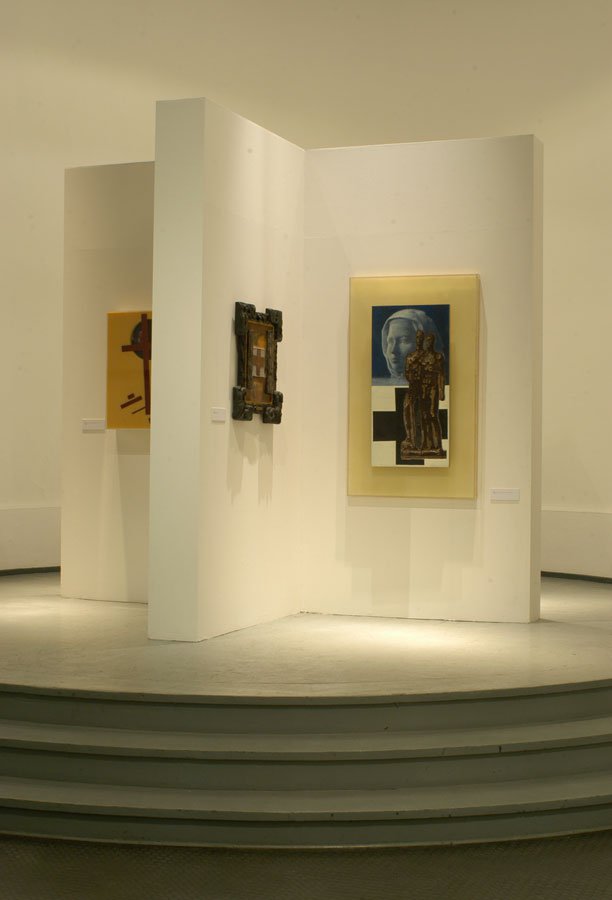
 IRWIN: RETROPRINCIP 1983-2003, Kunstlerhaus Bethanien, Berlin, 2003
IRWIN: RETROPRINCIP 1983-2003, Kunstlerhaus Bethanien, Berlin, 2003
The Model of the NSK-State -as the main object inside the installation- seems to consist of four integral parts:
First is the long narrow corridor also known from the virtual internet-version with its cryptic doors to the left and right leading to actually quite small or even nonexistent rooms. In some way, this corridor might symbolize either history or organisation (power/submission), both in some way meant as the long and difficult way of an individual towards the vision of his (perfect and impossible) state or national point of identification. Thus, the corridor leads to the interior center of the NSK-State, formed as some kind of symmetric room with a dome and consisting of three sections representing the main departments/groups of NSK:
The floor is formed by a large loudspeaker embedded in a symmetric cross and the sign "LAIBACH-STATE GENERATOR", the vertical sidewalls are decorated with small models of various IRWIN-paintings and the roof is formed as an observatory dome. Referring to the organisation of NSK-State, the symbolism of the model becomes clear: LAIBACH, as the "politicians" in NSK prepare the ground for a social structure with their propagandistic/propagating approach symbolized by the loudspeaker. Moreover, this loudspeaker was active and playing ancient golden LAIBACH-songs, among them "Der Zivilisation" and "Herzfelde", and thus extremely strengthening the massive NSK-atmosphere inside the cube. IRWIN, as historians and archive-keepers of NSK-State form the actually visible body of the state (walls and borders), visualizing and by the same time questioning its contents by the means of the fine arts (constructing history). Lastly, the dome seems to refer to the visions of the COSMOCINETICAL CABINET NOORDUNG with its theatrical/space appearance. As this very theatre section of NSK has always had the role of the religious aspect in NSK, its position high above the rest of the model is obviously chosen as a symbol either for heaven and infinite space or for the earthly parallel of technically equalling that, the building of a church.
Interesting to mention that during the 1990ies, parts of this model, the IRWIN-room and the NOORDUNG-dome to be exact, have already been built up on a 1:1 scale on IRWIN-exhibitions and NSK-events.
The fact that a leaden cube serves as a host to that installation is symptomatic for the "clash of symbols and ideologies" that IRWIN has always practised: Simple geometrical forms as part of modernist/avantgarde-symbolism are corrupted by the leaden material used to from them in this certain case: The leaden material can –in this sense- only be seen in its character of being heavy and static (as contrast to the modern idea of movement towards new ideas) and the fact that it relates to death in form of its hazardous chemical character and that it has always been a material used in the industrial production of ammunition. Moreover, the use of such an extremely static and heavy material to create the planit creates a paradox, as Malevich's idea of the planits always referred to suprematistic symbols that were meant to be absolutely the opposite of static and heavy.
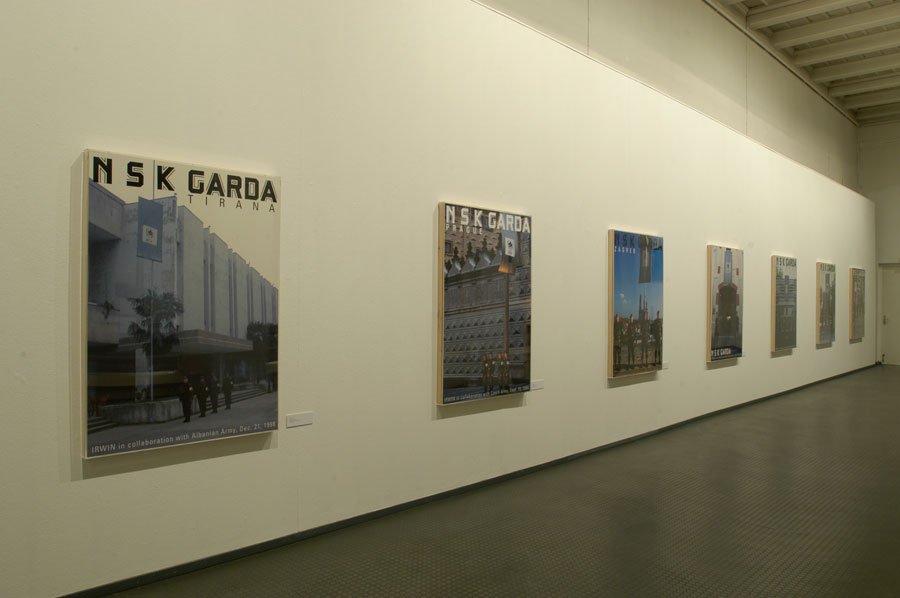
 IRWIN: RETROPRINCIP 1983-2003, Kunstlerhaus Bethanien, Berlin, 2003
IRWIN: RETROPRINCIP 1983-2003, Kunstlerhaus Bethanien, Berlin, 2003
Re-Connecting: "Transcentrala", "NSK Garda" and "Was ist Kunst Deutschland"
The "Transcentrala"-series consists of three photographs documenting three well-known artist events produced by IRWIN and supporters in the 1990:
"Kreuz" (New York, 1991): IRWIN painting a large symmetrical (Malevich-)cross on the rooftop of a New York-skyscraper.
"The Black Square on the Red Square" (Moscow, 1992): IRWIN and supporters installing a large black square made of canvas on Moscow's Red Square.
"NSK-Panorama" (Ljubljana 1997): IRWIN, LAIBACH and members of other NSK
groups dancing in a circle with traditionally dressed women on a field near Ljubljana.
What where these events possibly meant to be? And where is the connection between them that justifies their hanging right beside each other on this exhibition?
Speaking of "Kreuz", it might be seen as some kind of transportation of former "Eastern" symbolism (the suprematist Malevich-cross) to the center of what is meant to be a typical "Western" sphere and thus proving the importance of movement and different surroundings for the reception of certain symbols and ideologies. This concept of giving a great deal of importance to the idea of movement and variable spaces as a new vision besides the static idea of national states is strongly emphasizing the ideal of a free flow of information and culture to interchange thoughts in all parts of life, artistically, politically and socially. Paul Virilio refers to that idea as "trajective", as so me kind of a 3rd dimension besides objectivity and subjectivity, in the means of a movement from on point to another that changes the impression of static subjects and objects on the whole.
As an immanent part of the creation of "Kreuz", the fact that the black cross was actually painted with only white color (which seems to be on first sight an impossible oxymoron), creating white borders to emerge the shape of the cross from the underlying black rooftop, supports the idea of different approaches to specific symbols depending on the ground they are based upon, their causes and effects, and the fact that cause and effect might sometimes be impossible to separate from each other).
"The Black Square on the Red Square" seems to be in this sense some playing with the idea of borders and territories and how they are created and abolished, supported by the parallel event of the opening of "NSK Embassy Moscow" by the same time.
Concluding the series, "NSK Panorama" with its playful movement of national/traditionally dressed people dancing in a circle within a natural environment could be a representation of history repeating itself (in circles), symbolized by the traditional clothing, the even more traditional and earth-based background of nature, brought into that form by modern art (relating to the circle as a modernist geometrical symbol and IRWIN's event itself), thus closing the circle of history after a full turn.
Needles to say that this combination of cross, triangle and circle represents once again in its purest form the three basic suprematistic symbols.
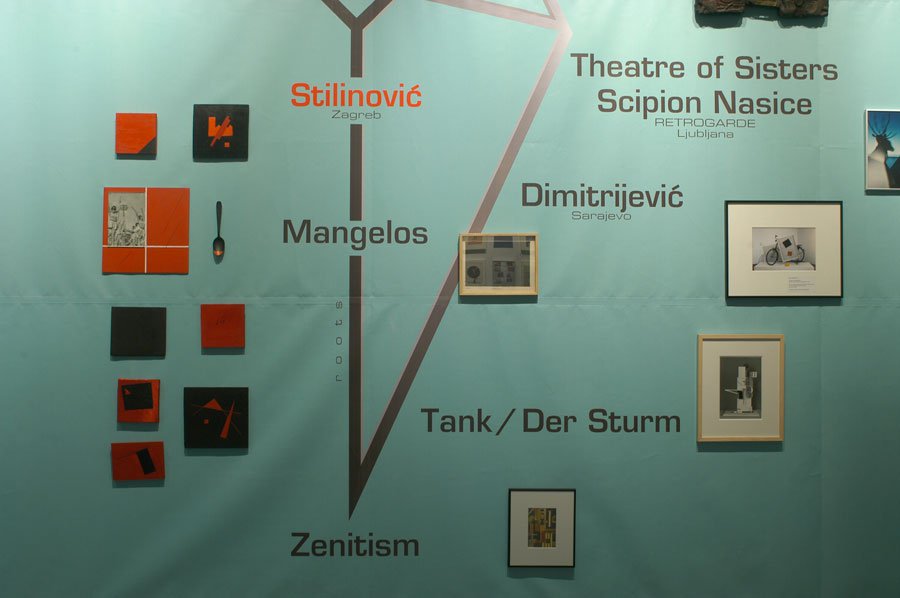
3 events. 3 symbols. 3 images.
3 basic inspirations for the matrix for life:
MOVEMENT - SPACE - TIME.
Speaking of these events of interaction, "NSK-Garda" leads further this idea on to a more institutionalised (and thus fitting the transformation of NSK from an art-collective to a state) basis: The movement of the explicitly non-territorial NSK-State all over the world in form of i.e. IRWIN-exhibitions, LAIBACH-concerts and combined NSK-events created in the past a whole bunch of crosslinks from this abstract virtual body to existing political, geographical and social structures. As examples may serve the fact that NSK-citizens were witnessed crossing international borders with their NSK-passports, or the temporary territorial materialisation of the NSK-State as i.e. in "NSK-STAAT BERLIN" in 1993 on what is basically meant to be territory of an already existing state. Pushing forward these ideas, NSK-Garda is by now the most impressing and most controversial example for such a crosslink between the NSK-State and existing state-structures, by in some way connecting to the most obvious historical symbol of state-power, the military. In some way, this could be seen either as a symbiotic and friendly cooperation between NSK and the hosting state or as some kind off subliminal hostile assimilation of this certain state by the NSK-state. Thus, with NSK-Garda, could IRWIN possibly (ab)use their hosting states, in form of using their military power, which should be meant to serve only its own state's goals, for purposes of NSK? Or, is it maybe something in between? Or, in other words: Whatever the answer to this question might be, from whom is NSK to be protected anyway by these guards? And: Shouldn't it make us think, that these armies that are equally protecting NSK by now, were in recent past on partly opposing sides in the war on the Balkans?
With "Was ist Kunst Deutschland", IRWIN seem to stress their principle of emphatic eclecticism to the extreme and by the same time return to the essence of one of their earliest statements when they, starting with their earliest paintings "found out that what we lacked was a frame". Seemingly concentrating on these two points, "Was ist Kunst Deutschland" is in fact nothing but a collection of original paintings of contemporary German modern artists "violently" forced into the IRWIN-context by putting them into the characteristic massive IRWIN-frames of heavy black materials with the well-known IRWIN-typical enlarged corners and the IRWIN-plate (inscribed "Was ist Kunst") instead of a signature. Controversial as ever, IRWIN seem to refuse to leave it to the viewer to decide about the question "Was ist Kunst?" (=what is art?) that they actually rise with this installation and its very name, but instead taking out the "?" on the signing plates, changing its words "Was ist Kunst" from their grammatical terms as a question to some kind of non-existing statement.
Before trying to interpret any deeper meanings of that, it has to be said that -most surprisingly- even in this extreme manner, the NSK-principle of copies without originals seems to work, although -ironically- the paintings to be seen are in fact the originals. Nevertheless, despite all the differences in style and technique of these paintings to the "usual" IRWIN-pictures, the whole collection seems to scream "IRWIN" into the spectators eyes on the first glance. Only a closer second look will reveal the fact, that the only thing IRWIN factually contributed to these works were the frames which is in "normal" artist terms nothing but bare practical necessity without much of an artistic value.
But is that not what the sentence "Was ist Kunst" wants to ask the spectator? Are these paintings something different now in the IRWIN-context than they might have been in their original context? Is it possible to transform existing works of art into a new context just by framing them differently (in a manner of changing the social/political/artist surrounding framework of the painting)? According to Inke Arns, it was -in spite of the violent conception of this installation- quite easy to persuade some museums and owners of the originals of the artistic value of this IRWIN-event and thus allow the use of their paintings for "Was ist Kunst Deutschland". Obviously, they themselves answered the question "Was ist Kunst" with an IRWIN-honouring "Das ist Kunst"...
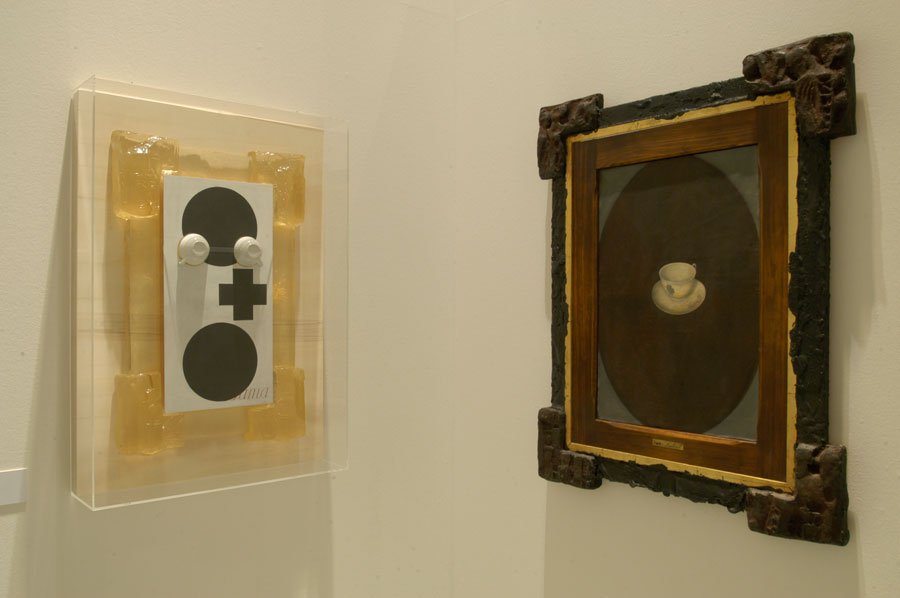
 IRWIN: RETROPRINCIP 1983-2003, Kunstlerhaus Bethanien, Berlin, 2003
IRWIN: RETROPRINCIP 1983-2003, Kunstlerhaus Bethanien, Berlin, 2003
Express the Inexpressible: "Retroprincip", "Retroavantgarda" and "East Art Map"
Studio 2 hosted in a large white room the interdisciplinary and partly multimedial installations "Retroprincip", "Retroavantgarda" and "East Art Map", as well as some documentary video-program and a selection of IRWIN-related book-material.
"Retroprincip" is in itself some kind of organisational chart meant to explain the three columns of IRWIN/s strategy and in this sense categorizing certain works and events of IRWIN within a larger context. Equalling once again organisational forms of states and governmental organisations, IRWIN here separate their work in the three basic categories:
"Geo-politics" (i.e. NSK-embassies, "Transnacionala", etc.), mainly representing the idea of movement of NSK crosslinked to questions of territory and politics.
"Politics of the artificial person" (i.e. "ICONS", "Was ist Kunst", etc.), relating these more global thoughts to questions of the individual within these systems.
"Instrumental politics" (referring to basic typical forms of fine arts like collections, exhibitions, catalogues, etc.) as basic "real-life" section of the concept.
"Retroavantgarda" for example is in this sense a possible attempt of IRWIN and collaborateur Marina Grzinic to visualize the historic context from which IRWIN's and NSK's principle of “Retroavantgarde” emerged, referring to different artists and styles in a historical chart similar to a technical diagram, once again abolishing the thought of free and creative artist ideas and advancing strict organisational imagery and accepting the means of cause and effect. Moreover, IRWIN does not only define itself in this installation, but take a step towards the (re-)construction of "Eastern Modernism"'s history. In this sense, it also parallels the similar project East Art Map, which was meant to construct this certain history of "Eastern Modernist" art after -in contrast to Western art- no formal history of this "modernism" has been written yet due to the political circumstances of its historical surroundings. In some way, this technical and static "construction" of an art history may also be some kind of ironic mocking about the static and self-centered view of Western "modernism"'s history. Fitting that, the multimedia-based installation of East Art Map shown is in its technical realisation also a gaming with perspectives: Different to the usual installation of a video-projection, the multimedial and interactive presentation of East Art Map (known form the East Art Map-site on the WorldWideWeb) was brought onto the top of a white table by a video-beamer hanging vertically above that table. By that, common perspectives of computerised input- and output devices (where the table should be the space for input) are changed to the opposite and by the same time paralleling the former project IRWIN LIVE with members of IRWIN hanging horizontally and eyes up under a gallery's ceiling and the paintings located above them.
In fact, these works are borderlining between being art themselves and being by the same time tools to the understanding of art. Thus, with these projects, IRWIN contribute in some way to contemporary Eastern Art on the whole (which they are themselves part of) by creating (equally to their own paintings) a frame for it and putting it into a new global context. Noble enough this task might be, it is theoretically quite complex and confusing as well. Art as a subject of art, creating frames and systems for pieces of art that were out of frames and systems before in their original context... In the conclusion, this is quite interesting, but I fear that the whole underlying meanings and purposes might be out of reach for the spectator, because they are too complex for even this deep form of confrontation and communication...
In other words: Art is a means of expressing the inexpressible, the hidden mechanisms, the suppressed emotions, the words between the lines. Thus, any attempt to explain art by the means of words, theories and diagrams only is in my eyes doomed to fail. Art is already "expressing the inexpressible", so who wants to step forward and express Art?
Maybe a statement of Slovenian philosopher Zlavoj Zizek on one of the accompanying video-documentations shown was the best description of NSK's and IRWIN's method of "Retroprincip" possible in a few words. According to him, most people think that an avantgardist should develop new ideas that has never been thought of before. But, in Zizek's opinion, a true avantgardist should instead make use of the positive aspects of all ideas of past times that already exist to create the purest essence of these ideas for the future. In the words of LAIBACH: "We are searching for solution's for the future. And we will be looking for them in the past if necessary."
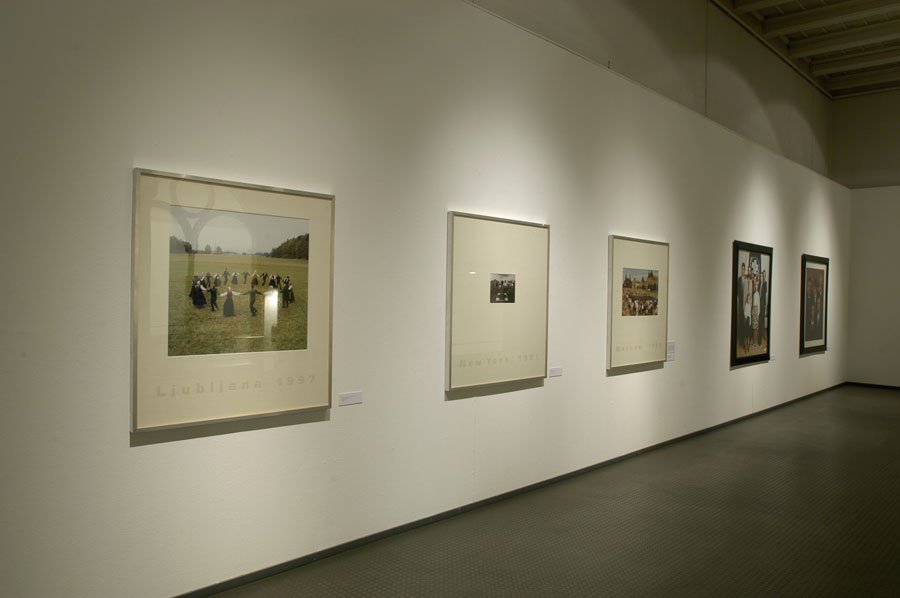
Epilogue
Anyway, even if not everything about IRWIN might be reached with theoretical explanations, the exhibition was in my eyes a good way of approaching IRWIN on the largest possible scale of contexts and a great opportunity to get an overview over 20 years of great artwork of IRWIN. In this sense, Inke Arns released an accompanying catalogue to the exhibition which is in fact much more than just an ordinary catalogue, but a large selection of IRWIN-related texts, interviews, interpretations that gives the reader an interesting overview of the whole phenomenon of IRWIN and partly other groups of NSK with most different approaches of interpretation. Hopefully, this exhibition, and those to follow in Hagen and Belgrade in the next months will be able to bring the ideas of IRWIN and NSK to a new and larger public by at least trying to give the best possible explanation of the exhibited works understandable maybe even for those that never before got in contact with IRWIN and/or NSK. Certainly, this hope is referring mainly to Germany, as, unfortunately and difficult to understand, IRWIN is up to know not quite well known in Germany, in contrast to other countries across Europe and worldwide where they already get the attention they -in my eyes- deserve.
With this hope as a positive attitude towards the exhibition we have witnessed, there might be a key to the understanding of the picture "The Golden Smile" which was used as some kind of "eye-catcher" for the exhibition on posters, flyers and the front cover of the catalogue. “The Golden Smile” shows a photography of the 5 members of IRWIN, smiling into the camera revealing golden teeth. What the hell is this ought to tell us? My personal opinion: Gold serves as a symbol for static and eternal stability and lasting values, thus paralleling materials used by IRWIN and the principle of "retro". It is -by the same time- in some way an ironic symbol for capitalist wealth, sarcastically showing IRWIN not as artists but just superficial people who have made it to pay for their living by the money they earn with what they are doing and not hesitating to show this wealth. But: More seriously taken, the smile might be meant as a human signal of friendliness and peace on the one hand, and of an aggressive showing of sharp teeth on the other hand. And is this not what IRWIN and NSK tend to push forward with their Art, to confront people with a certain evil for a noble and idealistic aim?
As -according to IRWIN- the future is the seed of the past, I am looking forward to IRWIN's future works (according to IRWIN-member Borut Vogelnik, there exist sufficient amounts of ideas for the next decade). If they have been able to be seed of the past 20 years of IRWIN, they will be certainly justified for the next retrospective...
... in the year 2023.
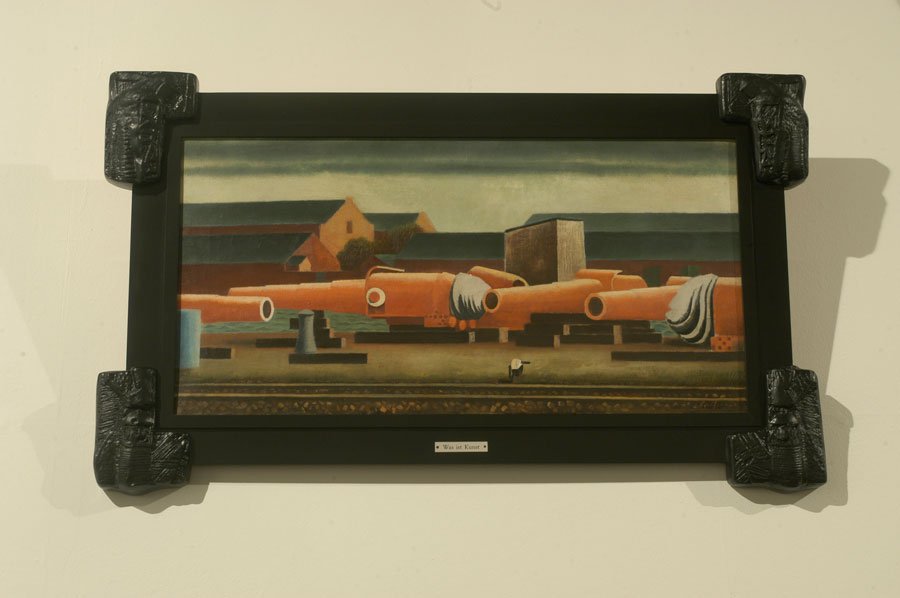
 IRWIN: RETROPRINCIP 1983-2003, Kunstlerhaus Bethanien, Berlin, 2003
IRWIN: RETROPRINCIP 1983-2003, Kunstlerhaus Bethanien, Berlin, 2003
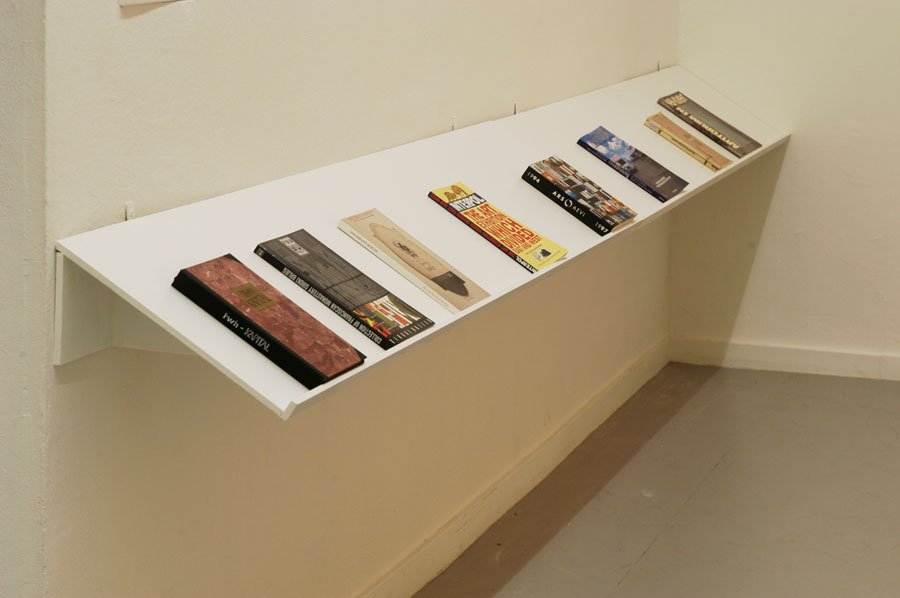
 IRWIN: RETROPRINCIP 1983-2003, Kunstlerhaus Bethanien, Berlin, 2003
IRWIN: RETROPRINCIP 1983-2003, Kunstlerhaus Bethanien, Berlin, 2003

